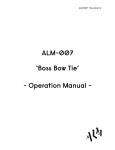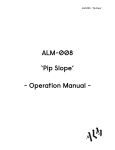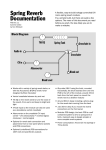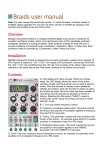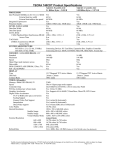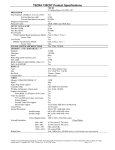Download ALM-011 `Akemie`s Castle` - Operation Manual -
Transcript
ALM-011 - ‘Akemie’s Castle’ ALM-011 ‘Akemie’s Castle’ - Operation Manual (V0.1) Introduction ............................................................................................3 Technical Specifications .......................................................................................3 Background & Caveats ............................................................................4 Core Operation .......................................................................................5 Panel Layout .........................................................................................................5 General Usage ......................................................................................................7 Patch Ideas ............................................................................................13 Limited Warranty ....................................................................................14 Support ...................................................................................................15 "2 ALM-011 - ‘Akemie’s Castle’ Introduction ‘Akemie’s Castle’ is a dual voltage controlled oscillator with authentic 4 Operator digital FM using ‘new-old-stock’ Yamaha IC’s for audio signal generation. Each of the 4 operators feature independent waveform selection, frequency multiplier and level control via both direct panel operation and voltage control. Operators can be combined in various ways across both oscillators, which together with independent feedback control on each VCO, offer an extremely wide palette of sounds. Oscillator A also features a chord mode providing a range of up to 5 voice chords and voltage controlled inversion. Technical Specifications • Supply: +/-12V • Current Draw: ~120ma • Size: 38 HP • Depth: 32mm (including power header) !3 ALM-011 - ‘Akemie’s Castle’ Background & Caveats Frequency Modulation (FM) synthesis is an audio synthesis technique where waveforms modulate each other at audio frequencies to produce a wide array of both harmonic and in harmonic sounds. These modulation waveforms are referred to as ‘operators’. The combination and routing of a number of operators to produce a sound is referred to as an ‘algorithm'. FM synthesis was made hugely popular is the mid 1980’s with the launch of the Yamaha DX7 synthesiser. Yamaha implemented this through the use of custom digital FM synthesis chips which were used not just across their synthesiser range but also in gaming machines and home computers. For more information visit: http:// en.wikipedia.org/wiki/Frequency_modulation_synthesis Akemie’s Castle uses a vintage ‘new old stock’ Yamaha YMF262 (aka OPL3) chip as a sound source and exposes all operator parameters to both voltage and direct control. It is able to produce multiple voice 2 or 4 operator FM based sounds from 6 algorithms and 7 selectable waveforms. This is very similar in audio capability to the Yamaha DX100, DX21 or TX81Z synthesisers. Using an original chip gives a very authentic and special sound that has never been put under direct modular control before. This allows easy, fun and painless exploration of FM sounds that was not really possible with the heavy, menu bashing small screen style of programming the FM synths of the 80s. However, using an original chip imposes some limitations, some of which become more apparent with such direct control. Expect some ‘stepiness’ and potential low level clicks when changing certain parameters. It is only possible to modulate parameters up to low audio rates. The chip will alias and even distort if pushed hard enough in certain settings - care should be taken. One can quickly go from rich tonal bliss to crushing noise. It is a beast, but one that can be tamed. Embrace and enjoy these limitations. !4 ALM-011 - ‘Akemie’s Castle’ Core Operation Panel Layout Please see next page for a panel diagram. --- Notes: All jacks are inputs expecting control voltages except the two VCO audio outputs at lower left. Full frequency range output is approx. 0.05Hz to just over 6kHz All inputs expect 0-5v except chord and V/Oct inputs which expect approx. 0-10v. All inputs with an associated white knob have a separate attenuator (or attenuverter). The white knob acts as an offset to which any incoming control signals are combined with (post attenuation). All inputs with a grey knob (i.e wave selection) act as an offset with no incoming control signal patched. With a control signal patched they become attenuators for the patched incoming signal. The V/Oct, ’Inv’ and ‘Fb’ inputs have no attenuation controls. Osc B ‘Fb’ input is normalised to the main Osc A ‘Feedback’ control - i.e with nothing externally patched into Osc B ‘FB’ input the main Osc A Feedback level will be used. Beware output levels can vary dramatically depending on operator setup and if chord more is enabled (level will increase!). Watch for distortion. !5 Audio outputs for each VCO Algorithm selection. How operators are combined and distributed to each of the VCO’s Seperate feedback input (normalised to Osc A feedback) B 3 B 4 sc B O ut 1 2 3 4 1 2 3 4 A O ut AB AB Operator section sc A Fb - + Inv Chord Chord Feedback O V/Oct Level - + Level Mult Multiplier Wave Operator - 1 Level - + Level Mult Multiplier Wave Level - + Level Mult Multiplier Wave Level -|+ Level Mult Multiplier Wave Operator - 2 Operator - 3 Operator - 4 — AKEMIE ’S CAST L E — 1 A 3 4 B 2 Operator Algorithm AB 1 2 3 4 AB 1 2 A O 1 2 3 4 Fb V/Oct Freq Oscillator B Section. Freq Oscillator A section. Includes frequency, feedback and Chord controls CV inputs with attenuverter and attenuator controls Operator amplitude level offset control. Operator frequency multiplier offset control Operator waveform selection control. Acts as attenuator when external CV patched ALM-011 - ‘Akemie’s Castle’ !6 ALM-011 - ‘Akemie’s Castle’ General Usage Akemie’s Castle is a dual VCO with 4 FM operators. The operators can be combined in various ways (the ‘algorithm’ ) and then routed to each or both VCOs as to produce a tone for the respective VCO. Each VCO’s base frequency is set via patching a voltage into the VCO’s V/Oct input. This value is combined with an offset set by both the course and fine knobs (i.e as to tune the oscillator). The audio tone in then output at the corresponding VCO output jack. There are 6 operator algorithm settings. The algorithms are stepped through by pressing the blue button of the left of the control panel. An LED then indicates the current selected algorithm. Each algorithm is represented by a small diagram showing the combination of Operators used and the VCO output routing. With the first two operator algorithms you essentially have 2 completely separate VCO's each with there own 2 operators. With the remaining 4 you essentially have a 4 operator duo-phonic VCO - the same algorithms and tonal config but a separate pitch input, feedback (normalised to VCO A) and audio output. In all modes VCO A has the ability to produce up to 5 voice chords. The first two algorithms are simple 2 operator combinations for each VCO providing each with either a parallel or serial type combination. In Serial the two operators frequency modulate each other (operator 1 modulates 2), in parallel the two operators are simply mixed together (No actual FM). 1 2 A Serial - FM’d 1 A 2 Parallel - mixed !7 ALM-011 - ‘Akemie’s Castle’ In the first algorithm VCO A is an FM combination of operators 1 and 2 whilst VCO B is a mix of operators 3 and 4. In the second this setup is reversed. 3 1 2 A B 4 1 A 3 4 B 2 The next 4 are more complex algorithms using all four operators and various combinations of both serial and parallel connections. 1 2 3 4 AB 1 2 3 4 AB 1 2 3 4 1 2 3 4 AB AB For example the first of 4 operator algorithms, all operators modulate each other, whilst the next two group of 2 operators modulate each other before being mixed together. The last two are more irregular arrangements. Generally the more operators generally the more complex the sound. Also the more FM connections the more complex the sound. !8 ALM-011 - ‘Akemie’s Castle’ The right half of the control panel provides controls and inputs for each of the the 4 operators. Each operator section is numbered as to match the algorithm diagrams. Each Operator has 3 Settings; Wave The selected waveform used by the operator. There are 8 different waveforms; Graphically represented they are; 1. Sine 5. Alternating (even) Sine 2. Half-Sine 6. ‘Camel’ Sine 3. ‘Abs’ Sine 7. Square 4. Pulse Sine 8. logarithmic sawtooth /Derived Square !9 ALM-011 - ‘Akemie’s Castle’ Multiplier The multiplication ratio applied to the V/Oct frequency as to then apply to carrier and modulation frequencies within the selected algorithm Ranges increasingly from 1 to 15. Level The amplitude level of the operator. Has a range of 0 to 63. Note it is normal in that; - Sweeping the level in some situations can cause low audible clicks (this is most noticeable in last 25% and in FM like setups). - Very low levels will not always completely mute a operator - there can be some bleed. Further to operator and frequency control, the output sound can be further controlled by both feedback and chords. Feedback As mentioned previously each VCO has a feedback setting which controls by how much (0-7 range) the initial operator in the current (per VCO) algorithm self modulates. Feedback can be used to produce an increasingly ‘coarser’ sound - beware however it is dependent on the operator setup as to how much effect feedback can have. Note feedback can also effect tuning. By default the feedback setting of VCO A is shared across to VCO B. By patching into VCO B’s ‘Fb’ jack this connection is broken and VCO B feedback can be independently controlled. !10 ALM-011 - ‘Akemie’s Castle’ Chords VCO A is able to produce up to 5 voice chords which the V/Oct input providing the root frequency of a selected to chord. The type of Chord is selected by the ‘Chord’ control offset and/or a control voltage at the associated Chord input. The chord selection with number of voices are as follows; 1. Fifth (2) 2. 1 Octave (2) 3. 2 Octave (3) 4. 3 Octave (4) 5. Major (3) 6. Minor (3) 7. Suspended (3) 8. Augmented (3) 9. Diminished (3) 10.Dominant 7th (4) 11. Major 7th (4) 12. Minor 7th (4) 13. Maj/Dominant 9th (5) 14. Detuned (3) 15. Detuned (4) 16. Detuned (5) !11 ALM-011 - ‘Akemie’s Castle’ Further to this Chords may be inverted by applying a voltage to the Chord ‘Inv’ input. Increasing the voltage increases the amount of inversion. Multiple voice chords can increase levels quite dramatically and cause distortion. Be aware of operator level settings - the final one(s) may need lowering when chords mode is enabled. There are a wide array of parameters that can be changed leading to an almost endless palette of sounds to be discovered. However care should be taken it can be very easy to go from tonal bliss to hissing noise. Sounds can become inharmonic and untuned. !12 ALM-011 - ‘Akemie’s Castle’ Patch Ideas Simple Sine Waves Useful for module tuning and calibration (also see trimmers on rear to adjust tracking), the module can simple sine waves with either initial algorithm selected and all chord, feedback, wave and multiplier controls all set fully CCW. Level control set dependant on selected Algorithm. Melodic Chord inversions With a chord activated try patching a slow moving LFO into the inversion input for some pseudo sequenced melodies. Adding further modulation to other inputs will further excite the sequence. Drum hits With a 4 operator algorithm selected and the chord control set full CW , try patching triggered envelopes with a very short attack and quick releases into Oscillator A V/Oct input. Also mult this envelope also in a VCA combining with Oscillator A output. Further mult into other Akemie inputs. Try adjusting a the feedback. A huge range of drum sounds can be discovered. More to come soon! !13 ALM-011 - ‘Akemie’s Castle’ Limited Warranty From the date of manufacture this device is guaranteed for a period of 2 years against any manufacturing or material defects. Any such defects will be repaired or replaced at the discretion of ALM. This does not apply to; • Physical damage arising for mistreating (i,e dropping, submerging etc). • Damage caused by incorrect power connections. • Overexposure to heat or direct sunlight. • Damage caused by inappropriate or mis-use. • Use of incorrect or non official firmware No responsibility is implied or accepted for harm to person or apparatus caused through operation of this product. By using this product you agree to these terms. !14 ALM-011 - ‘Akemie’s Castle’ Support For the latest news, additional info, downloads and firmware updates please visit the ALM website at http://busycircuits.com and follow @busycircuits on twitter. Please send any questions or comments to [email protected] !15















